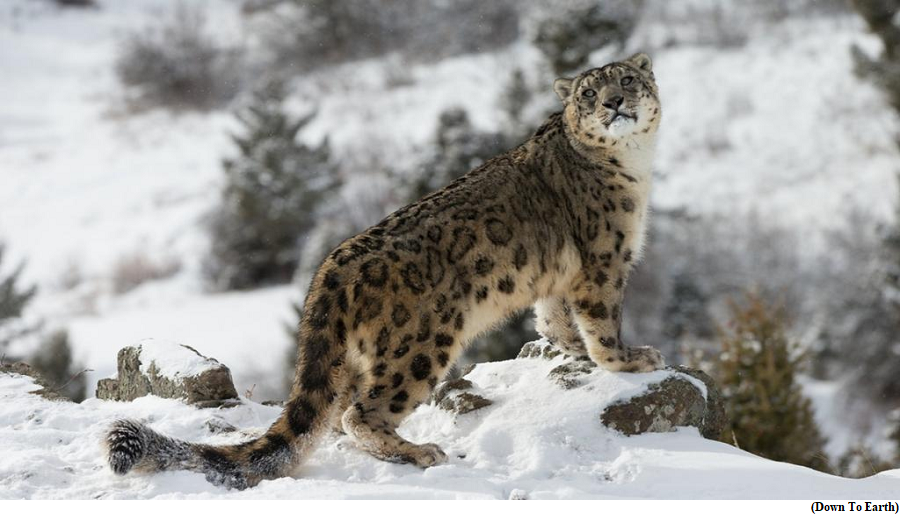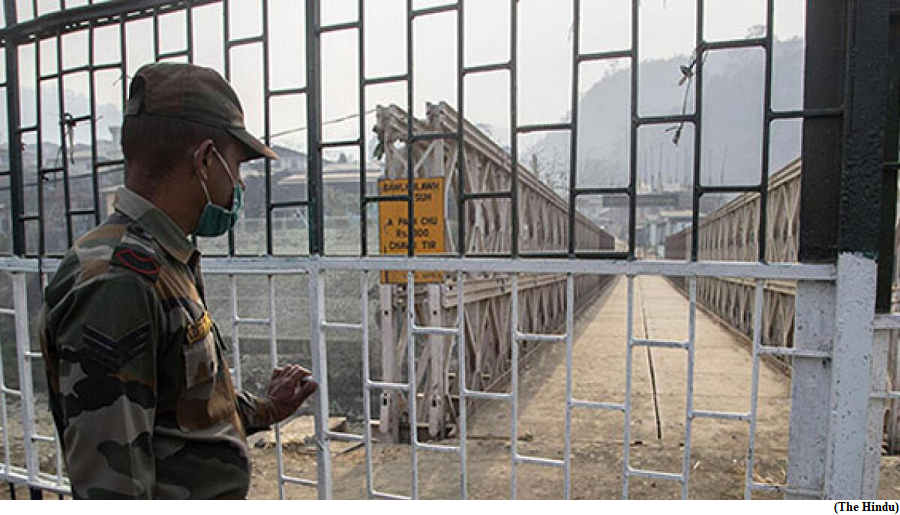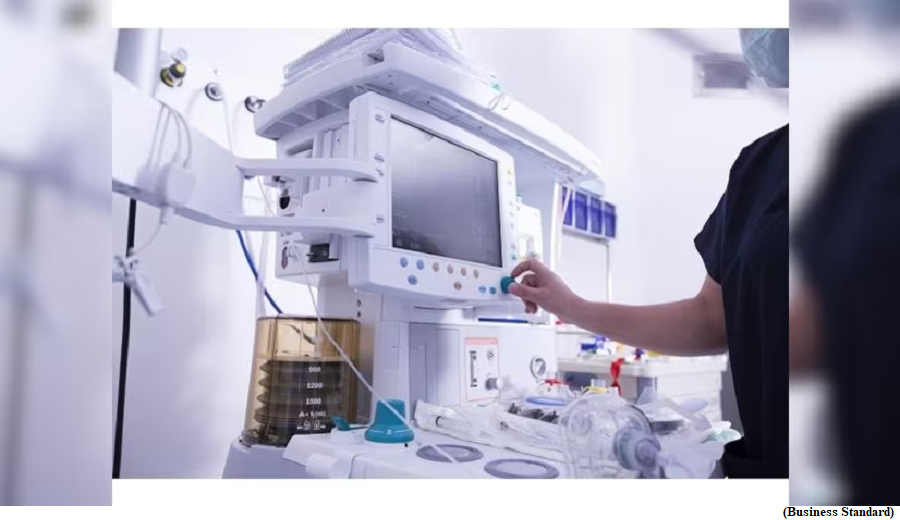Snow Leopard now National Symbol of Kyrgyzstan (GS Paper 3, Environment)

Why in news?
- The snow leopard, symbol of High Asia with its host of mountain ranges stretching from the Altai to the Himalayas, is now the national symbol of Kyrgyzstan, a former Soviet Republic in Central Asia.
- Sadyr Zhaparov, the President of Kyrgyzstan (which won its independence after the breakup of the Soviet Union in 1991), signed a decree on December 30, 2023 to this effect.
Highlights of the decree:
- The snow leopard was an important symbol of Kyrgyz culture. It features in the story of Manas, the Kyrgyz folk hero, as related in the Epic of Manas.
- The snow leopard is not only a symbol of natural wealth and cultural prosperity, but also an indicator of the stability and health of the mountain ecosystem, which occupies 1/3 of the global territory.
- The loss of snow leopards in the wild will lead to the risk of disturbing the fragile ecological balance, which will have a detrimental impact on various animal species and on humans.
- Ministries and agencies of the Kyrgyz Republic will henceforth collaborate to promote the snow leopard, organise protective measures, attract green investments, and utilise the symbol in promoting responsible tourism.
Mascot of Third Pole:
- There is critical need to make the snow leopard the mascot of climate adaptation in the ‘Third Pole’.
- Inner Asia comprises of mountain ranges such as the Altai, Tian Shan, Nan Shan, Kunlun Shan, Pamir, Karakorum, Hindu Kush, and of course, the Tibetan Plateau and the Himalayas.
- This region is home to most of the snow and ice on Earth outside the poles. From this region, at least 15 rivers fan out in every direction across the Asian continent.
- This ‘Water Tower of Asia’ provides essential ecosystem services, it provides clean water for a third of the world’s population. It is estimated to be warming at nearly two times the average rate of warming in the Northern Hemisphere.
Conservation:
- Snow leopard conservation received a boost a decade ago with the Bishkek Declaration on Snow Leopard Protection being unanimously adopted at the World Snow Leopard Conservation Forum in 2013.
- The GSLEP was subsequently initiated with the support of representatives from 12 snow leopard range countries (which includes India) and the international environmental community.
- The Global Snow Leopard and Ecosystem Protection Programme (GSLEP), an alliance of 12 snow leopard range countries, multi-lateral institutions, NGOs, scientists and local communities, is working to save the species.
Centre set to end Free Movement Regime at unfenced Myanmar border
(GS Paper 2, International Relation)
Why in news?
- The Union government is all set to scrap the Free Movement Regime (FMR) along the Myanmar border.
- People living in border areas, who could cross over to India, will soon require visas.

Details:
- India and Myanmar share an unfenced border, and people on either side have familial and ethnic ties, which prompted the arrangement in the 1970s. It was last revised in 2016.
- Around 300 km of the border will be fenced. A survey of the border areas with the help of drones has been completed.
FMR:
- Under the FMR, every member of the hill tribes, who is either a citizen of India or a citizen of Myanmar, and who resides within 16 km on either side of the border, can cross the border on production of a border pass, usually valid for a year, and can stay for up to two weeks per visit.
- The FMR was introduced in 2018 when relations between the Indian government and Myanmar were on the rise. The agreement aimed to facilitate people-to-people ties between the countries as residents in the region enjoy strong ethnic and familial relations on both sides of the border.
- The Manipur government has suspended the FMR since 2020, following the COVID-19 pandemic.
- Manipur Chief Minister has urged the Ministry of Home Affairs (MHA) to cancel the FMR along the India-Myanmar border and complete its fencing. He attributed the ongoing ethnic violence in the State to the free movement of people from across the border.
Migrant influx:
- After a military coup in Myanmar in February 2021, there was an influx of undocumented migrants, over 40,000 refugees took shelter in Mizoram, and around 4,000 refugees are said to have entered Manipur.
- The migrants belonging to the Kuki-Chin-Zo ethnic group share ethnic ties with communities in Mizoram and Manipur.
India-Myanmar border:
- India shares a 1,643 km-long border with Myanmar, which passes through the States of Arunachal Pradesh (520 km), Nagaland (215 km), Manipur (398 km), and Mizoram (510 km).
India launches a single window portal for medical devices management
(GS Paper 3, Economy)
Why in news?
- In a move to streamline the import, clinical investigations, and testing of medical devices, the Centre has launched the National Single Window System (NSWS).
- The NSWS has been established as a “genuine single-window system, which acts as a one-stop shop for all the approvals required by the investor and facilitates ease of doing business”.

Details:
- The NSWS porta has been developed by Tata Consultancy Services (TCS).
- It facilitates applications for the certificate of registration and licences to manufacture or import medical devices for various purposes, including clinical investigations, tests, evaluations, demonstrations, and training.
Medical devices in India:
- India’s demand for medical devices is projected to reach $50 billion by 2030. Currently, the country produces approximately $7.6 billion worth of medical devices, exporting roughly $3.4 billion.
- The annual demand for medical devices in India is estimated at around $12 billion, with imports accounting for close to $7.6 billion, or over 60 per cent, of the domestic requirement.
- However, the draft New Drugs, Medical Devices and Cosmetics Bill, 2023, expected to be tabled in Parliament soon, has triggered opposition from medical device makers, patient interest groups, and hospitals. They are advocating for a separate Bill for medical devices, distinct from drugs.
Background:
- Finance Minister Nirmala Sitharaman had previously announced the creation of an investment clearance cell (ICC) during her Budget speech on February 1, 2020.
- The proposed ICC, now developed as the NSWS, enables investors to identify, apply, track, and obtain the necessary approvals before starting any business operations in India, eliminating the need for investors to visit multiple IT platforms and authorities.




